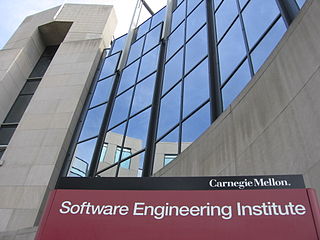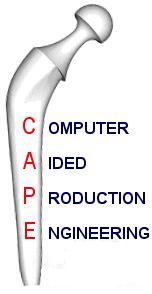Related Research Articles

In engineering and its various subdisciplines, acceptance testing is a test conducted to determine if the requirements of a specification or contract are met. It may involve chemical tests, physical tests, or performance tests.
The Capability Maturity Model (CMM) is a development model created in 1986 after a study of data collected from organizations that contracted with the U.S. Department of Defense, who funded the research. The term "maturity" relates to the degree of formality and optimization of processes, from ad hoc practices, to formally defined steps, to managed result metrics, to active optimization of the processes.

The Software Engineering Institute (SEI) is an American research and development center headquartered in Pittsburgh, Pennsylvania. Its activities cover cybersecurity, software assurance, software engineering and acquisition, and component capabilities critical to the Department of Defense.

Software architecture refers to the fundamental structures of a software system and the discipline of creating such structures and systems. Each structure comprises software elements, relations among them, and properties of both elements and relations. The architecture of a software system is a metaphor, analogous to the architecture of a building. It functions as a blueprint for the system and the developing project, laying out the tasks necessary to be executed by the design teams.
The Rational Unified Process (RUP) is an iterative software development process framework created by the Rational Software Corporation, a division of IBM since 2003. RUP is not a single concrete prescriptive process, but rather an adaptable process framework, intended to be tailored by the development organizations and software project teams that will select the elements of the process that are appropriate for their needs. RUP is a specific implementation of the Unified Process.
Software development is the process of conceiving, specifying, designing, programming, documenting, testing, and bug fixing involved in creating and maintaining applications, frameworks, or other software components. Software development involves writing and maintaining the source code, but in a broader sense, it includes all processes from the conception of the desired software through to the final manifestation of the software, typically in a planned and structured process. Software development also includes research, new development, prototyping, modification, reuse, re-engineering, maintenance, or any other activities that result in software products.
The following outline is provided as an overview of and topical guide to software engineering:
The Personal Software Process (PSP) is a structured software development process that is designed to help software engineers better understand and improve their performance by bringing discipline to the way they develop software and tracking their predicted and actual development of the code. It clearly shows developers how to manage the quality of their products, how to make a sound plan, and how to make commitments. It also offers them the data to justify their plans. They can evaluate their work and suggest improvement direction by analyzing and reviewing development time, defects, and size data. The PSP was created by Watts Humphrey to apply the underlying principles of the Software Engineering Institute's (SEI) Capability Maturity Model (CMM) to the software development practices of a single developer. It claims to give software engineers the process skills necessary to work on a team software process (TSP) team.
Capability Maturity Model Integration (CMMI) is a process level improvement training and appraisal program. Administered by the CMMI Institute, a subsidiary of ISACA, it was developed at Carnegie Mellon University (CMU). It is required by many U.S. Government contracts, especially in software development. CMU claims CMMI can be used to guide process improvement across a project, division, or an entire organization. CMMI defines the following maturity levels for processes: Initial, Managed, Defined, Quantitatively Managed, and Optimizing. Version 2.0 was published in 2018. CMMI is registered in the U.S. Patent and Trademark Office by CMU.
In the context of software engineering, software quality refers to two related but distinct notions:
Quality management ensures that an organization, product or service is consistent. It has four main components: quality planning, quality assurance, quality control and quality improvement. Quality management is focused not only on product and service quality, but also on the means to achieve it. Quality management, therefore, uses quality assurance and control of processes as well as products to achieve more consistent quality. What a customer wants and is willing to pay for it determines quality. It is a written or unwritten commitment to a known or unknown consumer in the market. Thus, quality can be defined as fitness for intended use or, in other words, how well the product performs its intended function.

Computer-aided production engineering (CAPE) is a relatively new and significant branch of engineering. Global manufacturing has changed the environment in which goods are produced. Meanwhile, the rapid development of electronics and communication technologies has required design and manufacturing to keep pace.
A software factory is a structured collection of related software assets that aids in producing computer software applications or software components according to specific, externally defined end-user requirements through an assembly process. A software factory applies manufacturing techniques and principles to software development to mimic the benefits of traditional manufacturing. Software factories are generally involved with outsourced software creation.
Domain engineering, is the entire process of reusing domain knowledge in the production of new software systems. It is a key concept in systematic software reuse and product line engineering. A key idea in systematic software reuse is the domain. Most organizations work in only a few domains. They repeatedly build similar systems within a given domain with variations to meet different customer needs. Rather than building each new system variant from scratch, significant savings may be achieved by reusing portions of previous systems in the domain to build new ones.
Model-driven engineering (MDE) is a software development methodology that focuses on creating and exploiting domain models, which are conceptual models of all the topics related to a specific problem. Hence, it highlights and aims at abstract representations of the knowledge and activities that govern a particular application domain, rather than the computing concepts.
Product-family engineering (PFE), also known as product-line engineering, is based on the ideas of "domain engineering" created by the Software Engineering Institute, a term coined by James Neighbors in his 1980 dissertation at University of California, Irvine. Software product lines are quite common in our daily lives, but before a product family can be successfully established, an extensive process has to be followed. This process is known as product-family engineering.

The CERT Coordination Center (CERT/CC) is the coordination center of the computer emergency response team (CERT) for the Software Engineering Institute (SEI), a non-profit United States federally funded research and development center. The CERT/CC researches software bugs that impact software and internet security, publishes research and information on its findings, and works with business and government to improve security of software and the internet as a whole.
In software engineering, a software development process is the process of dividing software development work into smaller, parallel or sequential steps or subprocesses to improve design, product management. It is also known as a software development life cycle (SDLC). The methodology may include the pre-definition of specific deliverables and artifacts that are created and completed by a project team to develop or maintain an application.
Software architecture description is the set of practices for expressing, communicating and analysing software architectures, and the result of applying such practices through a work product expressing a software architecture.
Bill Curtis is a software engineer best known for leading the development of the Capability Maturity Model and the People CMM in the Software Engineering Institute at Carnegie Mellon University, and for championing the spread of software process improvement and software measurement globally. In 2007 he was elected a Fellow of the Institute of Electrical and Electronics Engineers (IEEE) for his contributions to software process improvement and measurement.
References
- ↑ Software Product Lines Carnegie Mellon Software Engineering Institute Web Site
- ↑ Charles W. koushik,Introduction to Software Product Lines Archived 2012-02-04 at the Wayback Machine
- ↑ Software Product Lines Carnegie Mellon Software Engineering Institute Web Site
- ↑ Charles W. Krueger, Introduction to the Emerging Practice of Software Product Line Development
- ↑ ISO 26550:2015 – Software and systems engineering — Reference model for product line engineering and management .